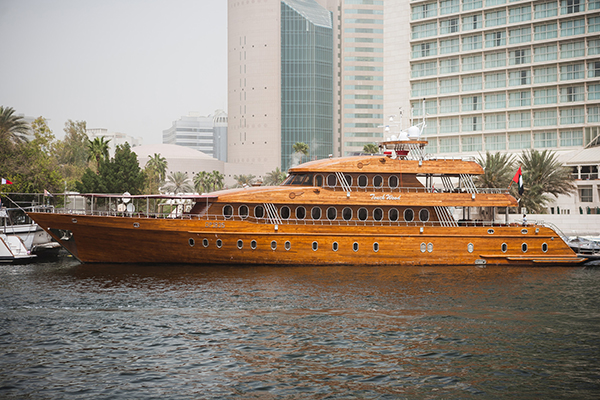
Dubai Creek is a 14-kilometer sea inlet where ancient history and modern glitz coexist. When it wasn't harboring yachts, fishing boats, and cargo ships, it was once a bustling port for trade. Dubai Creek was dredged in 1961 to improve navigation and the city's commercial importance. Today, it serves as a fascinating backdrop for waterfront restaurants and pays tribute to Dubai's maritime history. In contrast to the dimly lit promenade on the Deira side of Dubai Creek, the Dhow Wharfage is a bustling marketplace filled with waterfront eateries. One of the most well-known places to eat while at sea is Dhow Wharfage. Because of its long history of pearl diving, Dubai has a unique urban environment where the ocean and land combine. Captain Dunes is a leading provider of tour services in this illustrious region, promising an unforgettable adventure into the attraction of Dubai Creek.
Dubai Creek is a natural saltwater creek and tidal inlet in Dubai, UAE. It is a nine-mile-long watercourse that forms a natural port for the city. It has historically been used for trade and transport. Today, the watercourse is used by luxury yachts and is a popular tourist destination.
Dubai Creek is a natural seawater inlets of the Arabian Gulf that stretches for 14 kilometers and has numerous attractions for tourists. The creek is a popular tourist destination and has undergone redevelopment work. It is also a popular place to go for evening strolls. The Deira side of the creek has a promenade that is well lit. You can also visit the Dhow Wharfage, which is located beneath the Al Maktoum Bridge.
During the past, the creek was a thriving trading center, attracting people from the neighboring countries. Maritime commerce, pearling, and fishing were important industries that grew in the creek. The creek provided a safe harbour for wooden boats crossing the Gulf and produced a wealth of fishing and pearls.
Originally, Bur Dubai Creek served as an important port in the old days, where small canoes and small boats would plough the waterways from India and East Africa, trading pearls and fish. However, in 1961, Dubai Creek was dredged to a depth of seven feet to provide a more navigable channel for coastal shipping. The new dredge enabled vessels to pass through, opening new doors for trade and re-export. It also helped Dubai gain a competitive edge over the dominant trading centre Sharjah.
The old inlets were too narrow for big ship traffic. As a result, the old port of Jebel Ali was developed as a larger harbour. As a result, it became a hub for trade between the Arabian coastline and India and East Africa.
Dubai Creek is an area that is often used by luxury yachts. It’s one of the oldest areas of the city and is near the 3000 year old archaeological site of Saruq al Hadid. This waterfront area is home to luxury yachts, small fishing boats and cargo ships. The waterway is dotted with Abras, which are unique to Dubai.
Abras are water taxis in Dubai and are used to transport people from one part of the city to the other. They’re operated by the government and are a popular tourist attraction. These vessels are designed to be both beautiful and functional, and are a unique addition to the area.
One of the most famous tourist attractions in Dubai is Dubai Creek, a salt water creek with a rich Arabian heritage. While the rest of Dubai is awash with man-made wonders, the Creek stands out as a true representation of the city’s earlier days before the oil boom. The creek’s original purpose was to serve as a safe harbor for the many trading vessels operating along the ports of the Arabian Gulf. In the 1950s, it was discovered that the creek had split through the ground, creating a small canal. The creek runs through the center of the city and divides the city into two sections, Bur Dubai and Deira. The latter is home to the famed Deira Gold Souk.
When it comes to on-water dining, Dubai has many options to suit any palate. Many of the restaurants on the creek have a waterfront setting and provide unparalleled views. There are also a number of indoor restaurants and outdoor options. Whether you want to eat breakfast, lunch, or dinner, there are many options to fit any budget. Many of these restaurants also feature healthy choices, vegetarian options, and fresh juices.
One of the best areas to experience on-water dining in Dubai Creek Harbour is along the Dhow Wharfage area. The area is known for its many restaurants and is home to numerous markets. In addition, many of the sailors will let tourists see the inside of their dhows. There are also a variety of dhow cruises in the area.
Dubai Creek, a unique urban environment, is a natural setting where water meets land. This watery oasis serves as the inspiration for a vibrant new public realm. Dubai’s relationship with the water is an important part of its heritage. The earliest civilizations in the region enriched themselves through pearl harvesting. In turn, this brought personal wealth and regional prosperity. As a result, the Emirati culture places a high priority on a connection with the sea and this reflects in the contemporary metropolis.
The Creek is a 14 km long waterway. It was initially developed as a free-trade port, attracting cosmopolitans from neighboring countries to trade in pearls, spices, textiles, and gold. The area quickly became a thriving commercial center. Today, the creek is a vibrant urban environment, connected by traditional wooden boats.